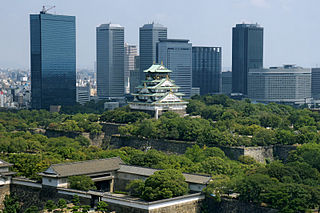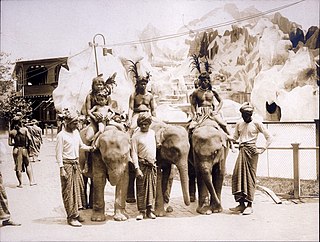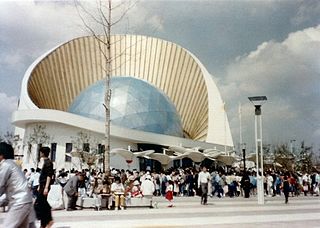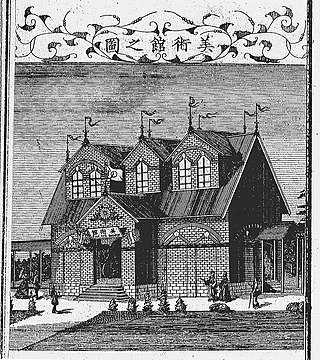Related Research Articles

A world's fair, also known as a fun exhibition or an expo, is a large global exhibition designed to showcase the achievements of nations. These exhibitions vary in character and are held in different parts of the world at a specific site for a period of time, typically between three and six months.

Osaka is a designated city in the Kansai region of Honshu in Japan, and one of the three major cities of Japan (Tokyo-Osaka-Nagoya). It is the capital of and most populous city in Osaka Prefecture, and the third-most populous city in Japan, following the special wards of Tokyo and Yokohama. With a population of 2.7 million in the 2020 census, it is also the largest component of the Keihanshin Metropolitan Area, which is the second-largest metropolitan area in Japan and the 10th-largest urban area in the world with more than 19 million inhabitants.

Nagoya is the largest city in the Chūbu region, the fourth-most populous city with a population of 2.3 million in 2020. It is one of the three major cities of Japan (Tokyo-Osaka-Nagoya). Located on the Pacific coast in central Honshu, it is the capital and most populous city of Aichi Prefecture, and one of Japan's major ports along with Tokyo, Osaka, Kobe, Yokohama, and Chiba. It is the principal city of the Chūkyō metropolitan area, which is the third-most populous metropolitan area in Japan with a population of 10.11 million in 2020.

The Bureau international des expositions is an intergovernmental organization created to supervise international exhibitions falling under the jurisdiction of the Convention Relating to International Exhibitions.

The Centennial International Exhibition, officially the International Exhibition of Arts, Manufactures, and Products of the Soil and Mine, was held in Philadelphia from May 10 to November 10, 1876. It was the first official world's fair to be held in the United States, and coincided with the centennial anniversary of the Declaration of Independence's adoption in Philadelphia on July 4, 1776.

The Exposition Universelle of 1900, better known in English as the 1900 Paris Exposition, was a world's fair held in Paris, France, from 14 April to 12 November 1900, to celebrate the achievements of the past century and to accelerate development into the next. It was the sixth of ten major expositions held in the city between 1855 and 1937. It was held at the esplanade of Les Invalides, the Champ de Mars, the Trocadéro and at the banks of the Seine between them, with an additional section in the Bois de Vincennes, and it was visited by more than fifty million people. Many international congresses and other events were held within the framework of the exposition, including the 1900 Summer Olympics.

Expo 2005 was a world expo held for 185 days between Friday, March 25 and Sunday, September 25, 2005, in Aichi Prefecture, Japan, east of the city of Nagoya. Japan has also hosted Expo '70 Osaka, Expo '75 Okinawa, Expo '85 Tsukuba, and Expo '90 Osaka and will host Expo 2025 Osaka.

The Japan World Exposition, Osaka, 1970 or Expo 70 was a world's fair held in Suita, Osaka Prefecture, Japan between March 15 and September 13, 1970. Its theme was "Progress and Harmony for Mankind." In Japanese, Expo '70 is often referred to as Ōsaka Banpaku (大阪万博). It was the first world's fair held in Japan and in Asia.

Human zoos, also known as ethnological expositions, were public displays of people, usually in a so-called "natural" or "primitive" state. They were most prominent during the 19th and 20th centuries. These displays sometimes emphasized the supposed inferiority of the exhibits' culture, and implied the superiority of "Western society", through tropes that purported marginalized groups as "savage". The idea of a "savage" derives from Columbus's voyages that deemed European culture remained pure, while other cultures were titled impure or "wild", and this stereotype relies heavily on the idea that different ways of living were "cast out by God", as other cultures do not recognize Christianity in relation to Creation. Throughout their existence such exhibitions garnered controversy over their demeaning, derogatory, and dehumanizing nature. They began as a part of circuses and "freak shows" which displayed exotic humans in a manner akin to a caricature which exaggerated their differences. They then developed into independent displays emphasizing the exhibits' inferiority to western culture and providing further justification for their subjugation. Such displays featured in multiple colonial exhibitions and at temporary exhibitions in animal zoos.

The 1873 Vienna World's Fair was the large world exposition that was held from 1 May to 31 October 1873 in the Austria-Hungarian capital Vienna. Its motto was "Culture and Education".

Expo 58, also known as the 1958 Brussels World's Fair, was a world's fair held on the Heysel/Heizel Plateau in Brussels, Belgium, from 17 April to 19 October 1958. It was the first major world's fair registered under the Bureau International des Expositions (BIE) after World War II.

The Seville Expo '92 was a universal exposition that took place from Monday, April 20 to Monday, October 12, 1992, on La Isla de La Cartuja, Seville, Spain. The theme for the expo was "The Age of Discovery", celebrating the 500th anniversary of Christopher Columbus reaching the Americas after launching from Seville's port, and over 100 countries were represented. The total amount of land used for the expo was 215 hectares and the total number of visitors was 41,814,571. The exposition ran at the same time as the smaller and shorter-duration Genoa Expo '92, a Specialized Exhibition, held in memory of Christopher Columbus, born in Genoa.

Expo '85, officially called the International Exhibition, Tsukuba Japan 1985, was a world's fair held in Tsukuba, Ibaraki, Japan between Sunday, March 17 and Monday, September 16, 1985. The theme of the fair was "Dwellings and surroundings – Science and Technology for Man at Home". Attendance was over 20 million and 48 countries participated, along with several companies.

The Tennōji Park is a park with botanical garden at 1–108, Chausuyama-cho, Tennōji-ku, Osaka, Japan.

The 1986 World Exposition on Transportation and Communication, or simply Expo 86, was a World's Fair held in Vancouver, British Columbia, Canada from May 2 until October 13, 1986. The fair, the theme of which was "Transportation and Communication: World in Motion – World in Touch", coincided with Vancouver's centennial and was held on the north shore of False Creek.

The Brussels International Exposition of 1910 was a world's fair held in Brussels, Belgium, from 23 April to 1 November 1910. This was just thirteen years after Brussels' previous world's fair. It received 13 million visitors, covered 88 hectares and lost 100,000 Belgian francs.
The following is a timeline of the history of the city of Osaka, Japan.

Expo 2025 is an upcoming World Expo organised and sanctioned by the Bureau International des Expositions (BIE), which will be held in Osaka, Japan. It will take place for six months during 2025, opening 13 April 2025 and closing 13 October 2025. This will be the third time Osaka hosts a World Expo, having previously hosted Expo 1970 and Expo 1990. The event will return to its traditional 5-year scheduling cycle after the Expo 2020 was delayed to 2021 and 2022 due to the COVID-19 pandemic. The projected visitor count is approximately 28 million.

The National Industrial Exhibitions were a series of five exhibitions in Meiji Japan, staged between 1877 and 1903, the first three in Tokyo, the fourth in Kyoto, the last in Osaka.
References
- 1 2 "Fifth National Industrial Exhibition | Part 1: Expositions Held in and before 1900 | Expositions, where the modern technology of the times was exhibited".
- 1 2 3 4 "Fifth Japanese National Industrial Exhibition, Osaka 1903" . Retrieved 29 May 2021.
- 1 2 "Expo 1970 Osaka: the story of Japan's first World Expo - BIE" . Retrieved 1 June 2021.
- 1 2 "Tennoji Park & Zoo – Osaka Station" . Retrieved 1 June 2021.
- 1 2 "China 29: 3D China:Pavilion Exhibits - World Fairs" . Retrieved 1 June 2021.
- ↑ "China at the World Expo" . Retrieved 1 June 2021.
- 1 2 3 Ziomek, Kirsten L (2014). "The 1903 Human Pavilion: Colonial Realities and Subaltern Subjectivities in Twentieth-Century Japan". The Journal of Asian Studies. 73 (2): 493–516. JSTOR. JSTOR 43553298 . Retrieved 31 May 2021.
- ↑ "Yosha Bunko" . Retrieved 31 May 2021.
- ↑ "Shuri Castle and Japanese Castles: A Controversial Heritage | The Asia-Pacific Journal: Japan Focus" . Retrieved 1 June 2021.
- ↑ 河世鳳 (2007). "Taiwan and Its Self-Images: The Case of Osaka Exhibition in 1903 | Semantic Scholar". 臺灣史研究. 14 (2). doi:10.6354/THR.200706.0001. S2CID 129992099.
- ↑ "STUDY ON BUILDINGS OF THE TAIWAN PAVILION IN THE FIFTH NATIONAL INDUSTRIAL EXHIBITION IN 1903 | Semantic Scholar]". doi:10.3130/AIJA.76.1693. S2CID 112157391.
{{cite web}}: Missing or empty|url=(help)